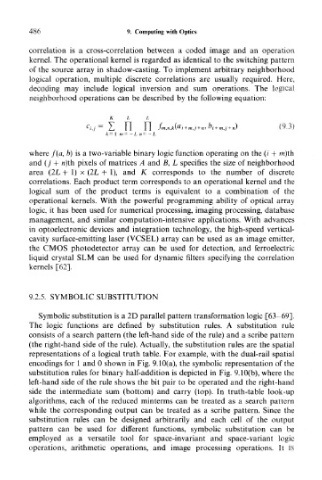Page 501 - Introduction to Information Optics
P. 501
486 9. Computing with Optics
correlation is a cross-correlation between a coded image and an operation
kernel. The operational kernel is regarded as identical to the switching pattern
of the source array in shadow-casting. To implement arbitrary neighborhood
logical operation, multiple discrete correlations are usually required. Here,
decoding may include logical inversion and sum operations. The logical
neighborhood operations can be described by the following equation:
=
i,j SOI !
k = I m = - L n=
where /(a, b) is a two-variable binary logic function operating on the (i + m)th
and (j + n)th pixels of matrices A and 0, L specifies the size of neighborhood
area (2L + 1) x (2L + 1), and K corresponds to the number of discrete
correlations. Each product term corresponds to an operational kernel and the
logical sum of the product terms is equivalent to a combination of the
operational kernels. With the powerful programming ability of optical array
logic, it has been used for numerical processing, imaging processing, database
management, and similar computation-intensive applications. With advances
in optoelectronic devices and integration technology, the high-speed vertical-
cavity surface-emitting laser (VCSEL) array can be used as an image emitter,
the CMOS photodetector array can be used for detection, and ferroelectric
liquid crystal SUM can be used for dynamic filters specifying the correlation
kernels [62].
9.2.5. SYMBOLIC SUBSTITUTION
Symbolic substitution is a 2D parallel pattern transformation logic [63-69].
The logic functions are defined by substitution rules. A substitution rule
consists of a search pattern (the left-hand side of the rule) and a scribe pattern
(the right-hand side of the rule). Actually, the substitution rules are the spatial
representations of a logical truth table. For example, with the dual-rail spatial
encodings for 1 and 0 shown in Fig. 9.10(a), the symbolic representation of the
substitution rules for binary half-addition is depicted in Fig. 9.10(b), where the
left-hand side of the rule shows the bit pair to be operated and the right-hand
side the intermediate sum (bottom) and carry (top). In truth-table look-up
algorithms, each of the reduced minterms can be treated as a search pattern
while the corresponding output can be treated as a scribe pattern. Since the
substitution rules can be designed arbitrarily and each cell of the output
pattern can be used for different functions, symbolic substitution can be
employed as a versatile tool for space-invariant and space-variant logic
operations, arithmetic operations, and image processing operations. It is

